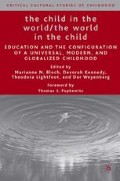Abstract
Can we understand first and second language learning among young children in a way that is both scientific and culture free? Both scholarship and teacher education in the fields of foreign and second language teaching are strongly grounded in the scientific theories of linguistics and cognitive psychology. Language learning and language teaching are frequently presented as “knowable” processes about which the truth can be discerned from two sources. One of these sources is direct observation of the process of teaching and learning foreign and second languages. The second source of information, however, often considered more “pure” than classroom observations of second language learning, is theoretical and empirical understandings of how young children learn their first languages as infants and as toddlers.
They said I should learn to speak a little bit of english don’t be scared of the suit and the tie learn to walk in the dreams of the foreigner.
(From Third World Child by Johnny Clegg and Savuka, cited in Pennycook, 1994, p.1)
Access this chapter
Tax calculation will be finalised at checkout
Purchases are for personal use only
Preview
Unable to display preview. Download preview PDF.
References
Bloom, P. (1996). Language acquisition: Core readings. Cambridge, MA: MIT Press.
Bloomfield, L. (1933). Language. Chicago, IL: University of Chicago Press.
Brooks, N. (1960). Language and language learning. New York: Harcourt, Brace and World.
Cha, B. (2002). Being Hmong is not enough. In Mai Ling Moua (Ed.), Bamboo among the oaks: Contemporary writing by Hmong Americans (pp. 22–31). St. Paul, MN: Minnesota Historical Society.
Chakrabarty, D. (2000). Provincializing Europe: Postcolonial thought and historical di erence. Princeton, NJ: Princeton University Press.
Chomsky, N. (1957). Syntactic structures. The Hague: Mouton.
Chomsky, N. (1959). Review of Verbal Behavior by B.F. Skinner. Language, 35, 28–58.
Chomsky. N. (1965). Aspects of the theory of syntax. Cambridge, MA: MIT Press.
de Beaugrande, R. (1991). Linguistic theory: The discourse of fundamental works. New York: Longman.
Gardner, H. (1987). The Mind’s New Science: A History of the Cognitive Revolution. New York: Basic Books.
Gee, J., Hull, G., & Lankshear, C. (1996). The new work order: Behind the language of the new capitalism. Boulder, CO: Westview Press.
Giddens, A. (1991). Modernity and self-identity: Self and society in the late modern age. Stanford, CA: Stanford University Press.
Hunt, M. (1994). The story of psychology. New York: Anchor Books.
Inoway-Ronnie, E. (1998). High/Scope in Head Start Programs serving Southeast Asian immigrant and refugee children and their families. In J. Ellsworth & L. Ames (Eds.), Critical perspectives on project Head Start. Albany, NY: State University of New York Press.
Jefress, L. (1951). Cerebral mechanisms in behavior: The Hixon Symposium. New York: John Wiley.
Krashen, S. (1981). Bilingual education and second language acquisition theory. In Bilingual education: Theory and practice (pp. 51–82), California State Department of Education. Los Angeles Evaluation, Dissemination and Assessment Center. Los Angeles: California State University Press.
Latour, B. (1983). We have never been modern. Cambridge, MA: Harvard University Press.
Maltz, M. (1960). Psycho-cybernetics: How to get what you want out of life. Englewood Cliffs, NJ: Prentice Hall.
Minsky, M. (1963). Steps towards artificial intelligence. In E. Feigenbaum & J. Feldman (Eds.), Computers and thought (pp. 406–450). New York: McGraw Hill.
Newell, A., Shaw, C. & Simon, H. (1963). Elements of a theory of human problem-solving. Psychological Review 65, 151–66.
Pennycook, A. (1994) The cultural politics of English as an international language. New York: Longman.
Phillips, S. (1972). Participant structures and communicative competence: Warm Springs children in community and classroom. In C. Cazden (Ed.), Functions of language in the classroom. (pp. 370–394) New York: Teachers College Press.
Pinker, S. (1994). The language instinct: How the mind creates language. New York: Harper Perennial.
Popkewitz, T. S. (1998). Dewey, Vygotsky, and the social administration of the individual: Constructivist pedagogy as systems of ideas in historical spaces. American Educational Research Journal, 35 (4), 535–570.
Rose, Nikolas (1990). The shaping of the private self. London and New York: Routledge.
Scollon, R., & Scollon, S. (1981). Narrative literacy and face in interethnic communication. Norwood, NJ: Ablex.
Scollon, R., & Scollon. S. (1995). Interculural comunication: A discourse approach. Cambridge, MA: Blackwell.
Simon, H. (1969). The Sciences of the Artificial. Cambridge, MA: MIT Press.
Strozer, J. (1996). Language acquisition after puberty. Washington, DC: Georgetown University Press.
Taylor, J. & Hardy, D. (2004). Monster careers: How to land the job of your life. New York: Pengu in Books.
Terell, T. (1981). The natural approach in bilingual education. In Bilingual education: Theory and practice (pp. 51–82), California State Department of Education. Los Angeles Evaluation, Dissemination and Assessment Center. Los Angeles: California State University.
Umrigar, T. (2001). Bombay Time. New York: Picador.
Watson, J. (1913). Psychology as the Behaviorist Views It. Psychological Review 20, 158–177.
Editor information
Editors and Affiliations
Copyright information
© 2006 Marianne N. Bloch, Devorah Kennedy, Theodora Lightfoot, and Dar Weyenberg
About this chapter
Cite this chapter
Lightfoot, T. (2006). Language Learning, Language Teaching, and the Construction of the Young Child. In: Bloch, M.N., Kennedy, D., Lightfoot, T., Weyenberg, D. (eds) The Child in the World/The World in the Child. Critical Cultural Studies of Childhood. Palgrave Macmillan, New York. https://doi.org/10.1057/9780230601666_5
Download citation
DOI: https://doi.org/10.1057/9780230601666_5
Publisher Name: Palgrave Macmillan, New York
Print ISBN: 978-1-349-53567-5
Online ISBN: 978-0-230-60166-6
eBook Packages: Palgrave Social & Cultural Studies CollectionSocial Sciences (R0)

